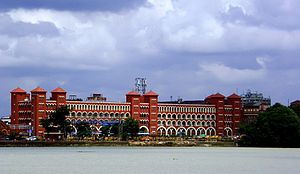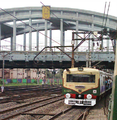Howrah railway station
This article has multiple issues. Please help improve it or discuss these issues on the talk page. (Learn how and when to remove these messages)
|
Howrah Junction হাওড়া জংশন हावड़ा जंक्शन | ||||||||||||||||
|---|---|---|---|---|---|---|---|---|---|---|---|---|---|---|---|---|
| Regional rail, Commuter rail, Light rail & Rapid transit station | ||||||||||||||||
 Howrah Station, view from Hooghly River | ||||||||||||||||
| General information | ||||||||||||||||
| Location | Lower Foreshore rd, Howrah - 711101 Howrah district, West Bengal India | |||||||||||||||
| Coordinates | 22°34′54″N 88°20′32″E / 22.5818°N 88.3423°E | |||||||||||||||
| Elevation | 12 metres (39 ft) | |||||||||||||||
| Owned by | Indian Railways | |||||||||||||||
| Operated by | Eastern Railway and South Eastern Railway Zone | |||||||||||||||
| Line(s) | Howrah-Delhi main line Howrah-Nagpur-Mumbai line Howrah-Chennai main line Howrah-Allahabad-Mumbai line | |||||||||||||||
| Platforms | 23 | |||||||||||||||
| Tracks | 26 | |||||||||||||||
| Connections | ||||||||||||||||
| Construction | ||||||||||||||||
| Structure type | Standard (on ground station) | |||||||||||||||
| Parking | Available | |||||||||||||||
| Other information | ||||||||||||||||
| Status | Functioning | |||||||||||||||
| Station code | HWH | |||||||||||||||
| Division(s) | Howrah(ER) | |||||||||||||||
| History | ||||||||||||||||
| Opened | 1854 | |||||||||||||||
| Electrified | 1954[1] | |||||||||||||||
| Previous names | East Indian Railway Company | |||||||||||||||
| Services | ||||||||||||||||
| ||||||||||||||||
Howrah Junction railway station (station code HWH) is the largest railway complex in India. With 23 platforms (the maximum number of platforms in the entire Indian railway system), it has the highest train-handling capacity of any railway station in India and is ranked as the busiest railway station in terms of passenger volume per day. It is one of the four intercity railway stations serving the city of Kolkata, the others being Sealdah Station, Santragachhi Station and Kolkata railway station. The terminal station is located on the West bank of the Hooghly River and is linked to Kolkata by Howrah Bridge.
A total of 293 passenger trains start, end, or pass through Howrah railway station.[2] A total of 1220 Stations are directly connected to Howrah railway station via these 293 passenger trains.[3]
History
Initial plans for the first Howrah railway station were submitted on June 17, 1851, by George Turnbull, the Chief Engineer of the East Indian Railway Company. In January 1852, it became clear that the government authorities would not sanction the purchase of sufficient land nor the necessary waterfrontage, despite remonstrations from Turnbull that the terminus would grow enormously. In May 1852, the detailed station plans were the major work of him and his team of engineers. In October, four tenders for building the station were received varying from 190,000 to 274,526 INR against an estimate of 250,000 INR.[4][5]
Due to a great increase of traffic, a new station building was proposed in 1901. The British architect Halsey Ricardo designed the new station. It was brought into service on December 1, 1905.[6] This building is the current Howrah station building. The station had 15 platform tracks.
It was expanded in the 1980s with the addition of 8 platform tracks in an area to the South of the station which previously had a parcels terminal, bringing the track count up to 23. At the same time a new Yatri Niwas (transit passenger facility) was built South of the original head house.
Platforms
There are currently 23 platforms in Howrah Station. Platforms 1-15 are located in the old complex also referred to as Terminal-1, while 17-23 are in the new complex (Terminal-2). Terminal-1 serves the local and long-distance trains of Eastern Railway as well as local trains of South Eastern Railway. Terminal-2 serves the long distance trains of South Eastern Railway.
Confluence of two railway zones
The station is served by the Eastern Railway for local trains to Belur Math, Tarakeswar, Arambagh, goghat, Katwa, Bandel, Sheoraphuli, Bardhaman, Serampore and numerous intermediate stations (see Main Line, Chord and Tarakeswar branch line); and mail/express trains to Central, North and North-East India. A narrow gauge line connects Bardhaman and Katwa and is currently served by DMU trains (all other lines run EMU trains). There is a plan to extend the suburban train service from Bardhaman to Mankar and Guskara, by electrifying the Khana–Guskara existing stretch, which is currently served by diesel loco hauled trains. The Bardhaman–Mankar stretch is now served by electric loco hauled trains.
The South Eastern Railway serves local trains to Amta, Mecheda, Panskura, Haldia, Tamluk, Haldia, Kanthi, Medinipur and Kharagpur; and mail/express trains to Central, West and South India. The Tamluk–Kanthi stretch is currently electrified and now EMU runs up to Digha. There is a plan to extend the suburban train service from Kharagpur to Jhargram, Hijli, Belda and Narayangarh. Both stretches are now served by electric loco (EMU) hauled trains.
Services
Trains from this station serve the Kolkata urban area via the Kolkata suburban railway, the state of West Bengal, and most major cities of India. Its twenty-three platforms handle over six hundred trains each day, serving more than a million passengers, making it the one of the busiest railway platforms in India . It is served by two zones of the Indian Railways: Eastern Railway and South Eastern Railway.
The station is operated by the Eastern Railway.
South Eastern Railway was previously known as the Bengal-Nagpur Railway (BNR, derisively called "Be Never Regular" because of its notorious tardiness) which built the trunk route from Kolkata to Nagpur connecting to Great Indian Peninsular (GIP) route to Mumbai and the trunk route to Vijayawada Junction connecting with the GIP route to Chennai. Eastern Railway was previously known as East Indian Railway (EIR) which built the trunk route from Kolkata to Delhi and beyond.
Four of India's most important trunk rail routes end in Howrah. They are Howrah-Delhi, Howrah-Mumbai, Howrah-Chennai and Howrah-Guwahati. Today there are 23 platforms in Howrah Junction /Central. The first Rajdhani Express in the country ran between Howrah and New Delhi in 1969. Eastern Railway handles trains for Northern, North-Western, North-Eastern & Eastern India through Barddhaman line & Katwa line. South Eastern Railway handles trains for Southern, South-Western, South-Eastern, Eestern, and central India through the Medinipur Line and Kharagpur Line. The Kanthi line is also serving long distance intrastate trains.
The Eastern Railway and South Eastern Railway section are connected by two links, one is Lilua-Tikiapara link, and other is Rajchandrapur/Dankuni-Maurigram link, currently used by goods trains and Sealdah-Puri Duronto Express. There are proposals to introduce more passenger train services on these two links to facilitate quick travel between the two sections avoiding Howrah.
Gallery
-
A Howrah bound EMU train in 2011.
-
The Bus Terminal which is located next to the station.
-
Howrah Station
-
The first locomotive, shown on the right and christened "multum in parvo" (barely visible on the wheel casing), which was used by the East Indian Railway Company in 1854 on its 23-mile line from Howrah to Pandua.
-
Yatri Nivas (Travellers' Lodge) at Howrah Station
-
Double Decker Train arrives at Howrah Station after a trial run
-
Howrah Railway Station Area
-
Old steam loco outside Howrah Junction
-
Old steam loco details
-
Howrah Junction - Welcome
-
Howrah Junction - Platformboard
Facilities
Howrah Station houses the divisional headquarters of the Howrah Division of the Indian Railway's Eastern zone.
For passengers it has an enormous covered waiting area between the main complex and the platforms. The main complex has waiting and retiring rooms for passengers awaiting connecting trains. In addition there is a Yatri Niwas with dormitory/ single room/ double room accommodation. The vehicular carriageways along the length of platforms allow passengers to be dropped near rail compartments — a facility unique among most major stations of the country.
The station complex includes the following:
- Two vehicular carriageways between platforms 8-9 (Eastern Railway) and 21-22 (South Eastern Railway) up to the length of the platforms. They connect to the flyovers at the end of platforms; facilitating quick exit of vehicles.
- Howrah offers excellent WiFi services to its users via MTS INDIAN RAIL WiFi.
- It has a very comfortable Air conditioned waiting room for first class passengers with a balcony view of the Kolkata Skyline and the Howrah Bridge.
- Diesel Loco shed (84 locos)
- Electric Loco Shed (96 locos). This also includes an electric trip shed with the capacity to hold around 15–20 locos. Interestingly, Howrah loco shed houses the second most number of WAP-4 class of locos, numbering a total of 100 locos.
- EMU Car Shed (15+ parking slots)
- Coach Maintenance Complex services many prestigious trains such as the Rajdhani, Duronto and Shatabdi expresses.
South Eastern railway's EMU car shed and electric loco shed are situated respectively at Tikiapara and Santragachhi. The Howrah Railway Complex also has a Railway Carriage and Wagons Workshop at Liluah, one of the three in the Eastern Railways. The other two being at Kanchrapara and Jamalpur.
North of the station there is now a new Railway Museum displaying artifacts of historical importance related to the development of Eastern Railway. For many years the Fairy Queen, now the world's oldest operational steam locomotive, was displayed on a plinth inside the station.[7]
Before 1992, there was a tram terminus at Howrah station. Trams departed from here towards Rajabazar, Sealdah Station, High Court, Dalhousie Square, Park Circus and Shyambazar. Trams also departed from here towards Bandhaghat and Shibpur. That terminus was partially closed in 1971 for closure of the Bandhaghat and Shibpur lines. Many unauthorised vehicles and people took over the tram-track carrying streets and it was impossible to continue the tram service on these routes. The state government wanted to close these lines rather than control buses, taxis, rickshaws and people to allow free tram movement. After these closures, the part of the terminus which served these two lines was re-constructed for underpasses and a bus terminus. But the other part still functioned until 1992, when the Rabindra Setu (Howrah Bridge) was declared not fit to carry trams, because it is a cantilever bridge. The tram line ran from the opening of the bridge until 1992. Previously routes 11, 20, 26, 30 & 32 served this terminus. Now the terminus is used by buses, and Some poles and stretches of track still exist.
When the Kolkata metro line 2 is built, it will pass through Howrah.
See also
- Shalimar railway station
- Santragachi railway station
- Sealdah railway station
- Kolkata railway station
- Kolkata suburban railway
- Kolkata Metro
- Kolkata tram
References
- ^ "[IRFCA] Indian Railways FAQ: Electric Traction - I". Irfca.org. Retrieved 13 June 2012.
- ^ "Trains plying through Howrah railway station". IndianRailways.info. Retrieved 21 September 2016.
- ^ "Stations directly connected to Howrah Railway Station". IndianRailways.info. Retrieved 21 September 2016.
- ^ Diaries of George Turnbull (Chief Engineer, East Indian Railway Company) held at the Centre of South Asian Studies at Cambridge University, England
- ^ George Turnbull, C.E. pages 110, 121, 122, 125 and 127 of the 437-page memoirs published privately 1893, scanned copy held in the British Library, London on compact disk since 2007
- ^ "Howrah Station is veritably the heartbeat of Kolkata". The Hindu. 2 December 2005. Retrieved 2 January 2009.
- ^ Ahrons, E.L. (1966). The British Steam Railway Locomotive. Vol. I, to 1925. Ian Allan. p. 142.










